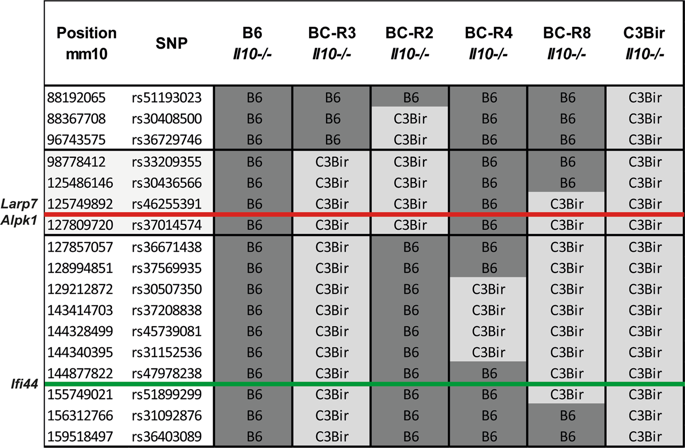Mucosal Immunology ( IF 7.9 ) Pub Date : 2019-01-18 , DOI: 10.1038/s41385-019-0133-9 Inga Bruesch 1 , Pascal Meier 1 , Marius Vital 2 , Dietmar H Pieper 2 , Kristin Selke 1 , Sebastian Böhlen 1 , Marijana Basic 1 , Martin Meier 1 , Silke Glage 1 , Joachim Hundrieser 3 , Dirk Wedekind 1 , Manuela Buettner 1 , André Bleich 1

|
Disease activity in Interleukin-10-deficient (Il10−/−) mice, a model for IBD, depends on genetic background and microbiome composition. B6.129P2/JZtm-Il10tm1Cgn (B6-Il10−/−) mice are partially resistant to colitis, whereas mice carrying the Cdcs1C3Bir haplotype on chromosome 3, B6.Cg-Il10tm1CgnMMU3(D3Mit11-D3Mit348)/JZtm (BC-R3-Il10−/−), are susceptible. This study was performed to clarify Cdcs1 and candidate gene effects on the colitogenic potential of hematopoietic cells using bone marrow (BM) and T-cell transfer models. Acute and chronic graft versus host reaction was excluded by high-density genotyping, in vitro and in vivo approaches. BM-chimeras were created with animals housed in two barriers (I and II) with distinct microbiota composition as identified by sequencing. BM-chimeras of all groups developed comparable moderate-to-severe colitis in Barrier I, however, in Barrier II only recipients of BC-R3-Il10−/− BM. Subsequent adoptive T cell transfers pointed to a new subcongenic interval within Cdcs1 affecting their colitogenic potential. Transfers excluded Larp7 and Alpk1 but highlighted Ifi44 as potential candidate genes. In this model-system, colitis development after cell transfer heavily depends on microbiome, though Cdcs1 acts mainly independently in hematopoietic cells. A new subcongenic interval, provisionally named Cdcs1.4, modifies colitogenic T cell function. Within this locus, Ifi44 represents an important candidate gene for colitis expression.
中文翻译:

对造血区室中 Cdcs1 致结肠炎效应的分析揭示了明显的微生物组相互作用和 T 细胞中活跃的新亚同类间期
白细胞介素 10 缺陷 ( Il10 -/- ) 小鼠(一种 IBD 模型)的疾病活动取决于遗传背景和微生物组组成。B6.129P2/JZtm- Il10 tm1Cgn (B6- Il10 -/- ) 小鼠对结肠炎有部分抵抗力,而在 3 号染色体上携带Cdcs1 C3Bir单倍型的小鼠,B6.Cg- Il10 tm1Cgn MMU3(D3Mit11-D3Mit348)/JZtm (BC -R3- Il10 −/− ), 是易感的。进行这项研究是为了阐明Cdcs1和候选基因对使用骨髓 (BM) 和 T 细胞转移模型的造血细胞的致大肠杆菌潜能的影响。高密度基因分型、体外和体内方法排除了急性和慢性移植物抗宿主反应。BM-嵌合体是用饲养在两个屏障(I 和 II)中的动物创建的,这些屏障具有通过测序鉴定的不同微生物群组成。所有组的 BM 嵌合体在 Barrier I 中发展了相当的中度至重度结肠炎,然而,在 Barrier II 中仅接受 BC-R3- Il10 -/- BM。随后的过继性 T 细胞转移指向 Cdcs1 内的一个新的亚同源间隔,影响它们的致结肠炎潜力。转移不包括Larp7和Alpk1,但突出显示Ifi44作为潜在的候选基因。在这个模型系统中,细胞转移后结肠炎的发展在很大程度上取决于微生物组,尽管Cdcs1主要在造血细胞中独立发挥作用。一个新的亚同类区间,暂时命名为Cdcs1.4,修改致结肠炎 T 细胞功能。在该基因座内,Ifi44代表结肠炎表达的重要候选基因。











































 京公网安备 11010802027423号
京公网安备 11010802027423号